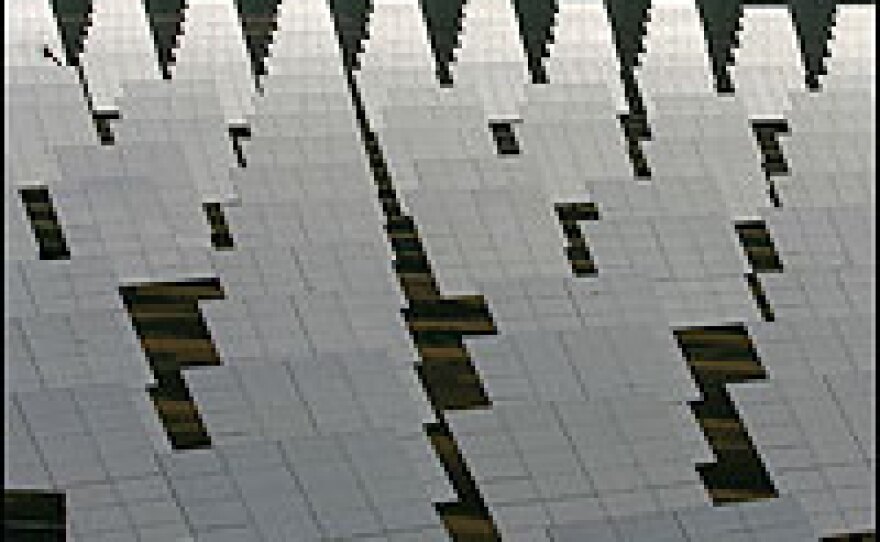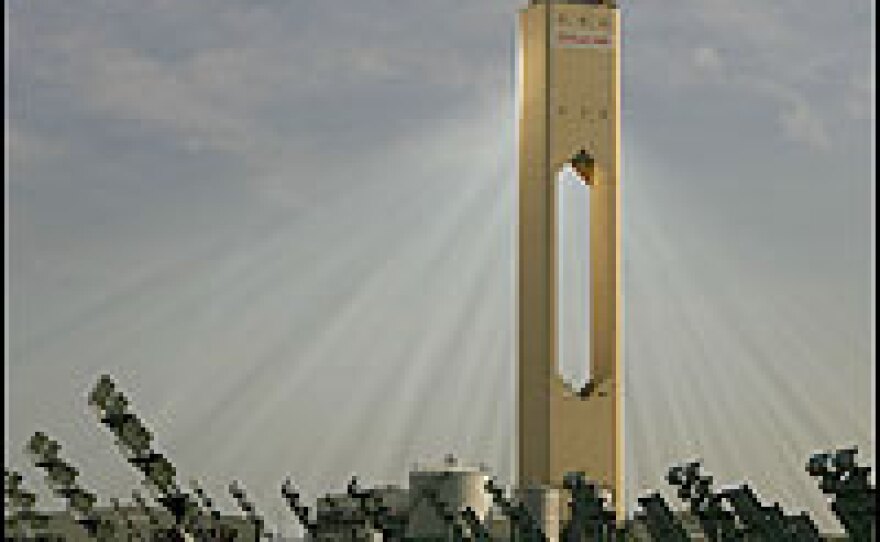
A company in Spain has started producing household electricity from a solar power plant near Seville.
The technology is called concentrated solar thermal energy, which means it uses heat from the sun to run steam turbine generators. And running it doesn't generate any greenhouse gases.
There's not a cloud in the sky on the dusty plain outside Seville. But in the distance, there's a glow from what looks like an upside-down funnel of light beams converging on a sleek, white tower.
Those light beams come from giant mirrors on the ground reflecting the sun's rays.
It's Europe's first commercial solar thermal power plant — and it's called PS-10.
"PS-10 is an 11-megawatt electric power plant and it's providing electricity for a population of about 6,000 houses," says Valerio Fernandez, the engineer in charge of the plant built by the Spanish renewable energy company, Abengoa. The plant has been operational since March 2006 and is still being expanded.
Bulldozers are clearing the ground for more banks of mirrors and solar towers that will bring the plant's output up to 300 megawatts.
Fernandez says that when all of the solar platforms are erected in 2013, with 300 megawatts, the plant will be supplying electricity to about 180,000 houses. That is about the same as the population of a city like Seville.
Fernandez opens the door to the chamber that houses the noisy turbines at the base of the tower. Up on an observation platform, he looks out over a vast plain that could easily be a prairie in the southwestern United States. But instead of cornfields, there are shimmering fields of heliostatic mirrors — mirrors that automatically follow the sun.
"This is one of the most beautiful views in the plant," Fernandez says. "We are 30 meters high in this platform that is in the middle of the tower, and you can see the whole heliostat field."
There are 624 solar panels reflecting sunlight up to the tower. You can actually see the light beams focusing on a point. And at that focal point there are flashes and little puffs of smoke — specks of drifting dust being vaporized.
The solar energy concentrated at the top could easily melt metal, Fernandez says. But water pumped through them stops them from melting. That water eventually turns to steam, powering the turbines at the base.
Seville gets up to 300 days of sunshine per year. Fernandez has a vision of solar towers dotting the landscape across southern Spain and even into northern Africa, generating power for rainy, northern Europe.
His company is already setting up plants in Morocco and Algeria, and is in negotiations to build more in California, Nevada and New Mexico.
When the Seville plant is finished, it will have cost more than one and a half billion dollars to build. It is only economically viable because of generous subsidies from the Spanish government and the European Union. But Fernandez says the technology is already getting cheaper.
At Seville's train station, passengers waiting for the train to Granada say they're glad the project has been built in southern Spain.
Almudena Molina thinks energy should be subsidized even more.
There's so much sun down here, she says, that you might as well put it to good use.
Her father, Antonio Molina, says projects like the solar tower should be built now, before global warming gets worse.
Copyright 2022 NPR. To see more, visit https://www.npr.org. 9(MDAzMjM2NDYzMDEyMzc1Njk5NjAxNzY3OQ001))







